
VOL. I NO. 49 REG. NO. L5015 DELHI, THURSDAY AUGUST 19, 1943.
ALLIED LEADERS MEETING IN QUEBEC
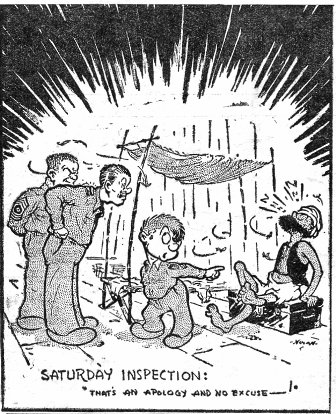
|
WAR STRATEGY DISCUSSED
SECRET F.D.R.-CHURCHILL HUDDLE AT HYDE PARK REVEALED
WASHINGTON - Now it all comes out. The veil of mystery which hung over White House comings and goings last week has been lifted to reveal that one of the most important war strategy conferences in United Nations' history has begun in Quebec.
Late last week, a special train crossed the United States-Canadian border carrying a distinguished visitor - Winston Churchill, Prime Minister of Great Britain - to an undisclosed U.S. destination. On Saturday, five different trains arrived in Quebec, each one carrying a different member of the American High Command, with his own group of advisors. At the same time, President Roosevelt disappeared from the White House.
HYDE PARK MEETING
Later, it was revealed that Churchill and Roosevelt met at Hyde park for three days. What they discussed can be guessed at, but was not revealed. Simultaneously, Admirals William E. Leahy and Ernest J. King, Gens. George C. Marshall and H. H. Arnold, and lt. Gen. Brehon Somervell sat down at a conference table with Lt. Gen. Sir Alan Brooke, Chief of the Imperial General Staff, Adm. Sir Dudley Pound, First Sea Lord, and Air Chief Marshal Sir Charles Portal, as well as the Canadian chiefs of staff and many specialists.
Indications are that Churchill and Roosevelt discussed broad general strategy at Hyde Park and arrived at strategic decisions which were then turned over to the military staffs for technical development. After this stage of the proceedings has been finished, it is announced that Roosevelt will go to Quebec to sit in on the final deliberations. Anthony Eden, British Foreign Minister, also is en route for the final sessions.
NO RUSS REPRESENTATION
The Russians are not represented, although Roosevelt has been quoted as saying he would be "awfully glad" if Stalin could attend.
However, the most detailed memorandum yet to come out of Russia, it is reported, had been received by the Washington and London governments prior to the conference's beginning and is serving as an important basis for deliberation. It also was announced that Eden and Under-Secretary of State Sumner Welles will visit Stalin after the conference, to give a first-hand account of everything that happened.
Unique Camera To Film Fights In Burma Skies
ASSAM AIR BASE - "Battle in the Air Over Burma - As Seen Through A Fighter Pilot's Gun Sights" could be the title of a film the War Department will soon have at its disposal.
In a belly tank slung under the sleek body of a P-40 has been installed a 35mm movie camera. When the pilot goes into action he merely presses a button on his dashboard and the entire action is filmed.
"The camera's lenses are sighted on line with the 50-caliber machine guns in the wings," said Capt. Clifford M. Shirpser, 36, Los Angeles, a former Hollywood photographer who designed the work.
WATCH TRACERS
"Future audiences will see tracer bullets converge directly on an enemy fighter as it bursts into flame or they can watch Japanese Army barracks go up in smoke when we swoop in low on ground missions."
The ship is flown by Capt. Charles G. Goff, 27, Three Rivers, Mich., who intends to take it along when fighters dive-bomb railroad bridges and ammunition dumps in Burma.
"We hope to use it to give fresh pilots a better idea of what they will face," he said.
The entire camera looks, but for the plastic nose, like an ordinary belly tank.
WEIGHS 55 POUNDS
Sgt. James K. Foley, 33, Mission, Tex., and William Gross, 38, Los Angeles, welded the composite parts into their present wind-resisting form and insist that the whole thing weighs only 55 pounds and can be dropped if the ship has to lighten load and get away from a Zero.
They have built the film compartment to take as much as 400 feet of film and have put in lenses that give a far clearer view of the ground than even the pilot gets.
"Clunk and clinker" is the name they have given it - baby shark below the large one painted on the ship's nose.
10TH A.F. BOMBERS HOLD ACTIVE WEEK;
WEATHER KEEPS FIGHTERS GROUNDED
B-25 Accounts For Four Ships On One Mission
Bombers of the 10th Air Force last week "skipped" around in an all-bomber show. Pittsburgh visibility kept the birds and our fighter pilots walking. Plenty of Nip shipping is trying to sail on the bottom instead of on the top as a result of these antics. One B-25 alone accounted for four in a single day. One bomber missing later turned up safe.
On August 9, reports tell of an attack on Sedaw, where a locomotive scattered itself over the landscape.
B-25's went to town the following day, but the crew of the ship piloted by F/O Thomas J. Smith, Jr., had the most fun. They sank two 200-foot ferry boats, t 50-foot river steamer and capsized an 80-foot barge in the Irrawaddy. Other B-25's plastered targets from the Arakan coast to Mandalay, with Akyab receiving the brunt of the attack.
SANK RIVER BOAT
Medium bombers went out "skip-bombing" again on the 12th - this time to central Burma. They sank a large river boat and damaged another in the Chindwin south of Monywa. For good measure, a bridge was damaged eight miles northeast of Monywa. It was on these operations that we lost our only aircraft of the week.
On the same day, B-24's damaged buildings and railroad tracks at the rail terminal of Ye on the Tennasserim Peninsula.
Meanwhile, the B-25's were still at it. Rolling stock and storage buildings went up in smoke at Kinu. Damage was done to tracks at the reversing station of Sedaw. A 200-foot river steamer was left on the bottom of the Chindwin 10 miles north of Monywa. Docks in the area got it. Near Katha, five barges were "skipped" and 20 freight cars strafed. Near Kanni, hits were made on two 75-foot river steamers. Another of the same near Mali. Other shipping sunk or damaged in the Irrawaddy included three ferry barges near Sagaing, a 100-foot river steamer and two large barges at Myinmu and a 100-foot steel barge at Natkayaing. Three locomotives and several freight cars were busted at Zigon and Tantabin. The railroad marshaling yards at Myingan ain't the same.
MADE BIG SPLASH
B-24's on the 13th disabled a 150-foot motor vessel near Diamond island off the Burma coast. An enemy fighter tried to horn in, but made a big splash in the Bay of Bengal after one attack. The B-25's relaxed by removing rolling stock and an oil dump at Shwebo.
An enemy freighter 175 feet in length got it south of Rangoon. Two direct hits caused an explosion followed by fires. When last observed, it was listing to port and sinking by the stern.
On the 15th, B-24's paid a call on Chatham Island in the Andaman Group. Warehouses and other buildings were b\ombed, causing widespread destruction and starting large fires. One anti-aircraft battery has fired its last shot.
The B-25's, like a hostess in a Kansas City clip joint, never seem to get enough. On the 16th, they made things miserable around Mandalay. They're just now coming out of their holes at Sagaing, Alon, Wunbye, Ywataung and Chaung-u.
&\nbsp; Sgt. Nick Lyseczko, Roundup staff lens artist, returned to the office the other day with the series of photographs which make up today's picture page. "Those guys," he lauded, "are doing a helluva job out there in the jungle." By "those guys" he meant a group of medical staked out in Assam to care for sick and injured G.I.'s in far-flung outposts. Dak porters carry in supplies and food to the isolated unit, which has made its camp as homelike as possible by improvisation and ingenuity. So you're griping you didn't enjoy the movies last night?
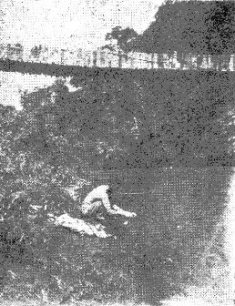 When it's laundry time, members of the medical outpost hike down to the river like Pvt. Don Booth.
When it's laundry time, members of the medical outpost hike down to the river like Pvt. Don Booth.
|
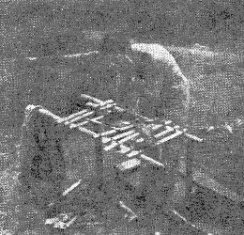 Sgt. Robert Fromant props his helmet upon a bamboo stand to use as a wash basin. Nothing fancy here.
Sgt. Robert Fromant props his helmet upon a bamboo stand to use as a wash basin. Nothing fancy here.
|
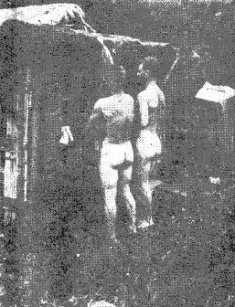 A shower? When it rains, stand under the eaves of the roof like Pvt. Nick Romeo, left, and Booth.
A shower? When it rains, stand under the eaves of the roof like Pvt. Nick Romeo, left, and Booth.
|
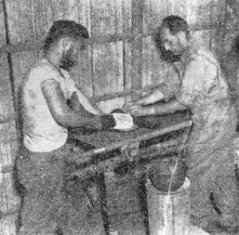 In a basha dispensary, Lt. Art Sonnenberg, right, and Booth bandage a leg injury of an Indian porter.
In a basha dispensary, Lt. Art Sonnenberg, right, and Booth bandage a leg injury of an Indian porter.
|
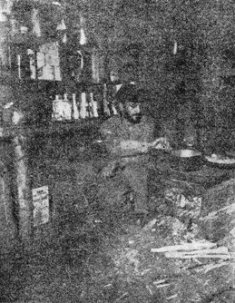 Pfc. Russell A. Musarra has discovered that bamboo is an adequate fuel to use when cooking meals.
Pfc. Russell A. Musarra has discovered that bamboo is an adequate fuel to use when cooking meals.
|
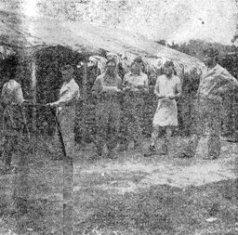 Mail time is the biggest moment of the day. Dak porters carry the "sugar reports" to the outpost.
Mail time is the biggest moment of the day. Dak porters carry the "sugar reports" to the outpost.
|
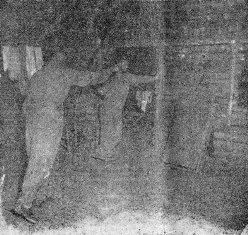 Entertainment is a difficult problem for this hard-working group of jungle medics. Sonnenberg amuses himself
in a rugged game of darts, while Booth watches.
Entertainment is a difficult problem for this hard-working group of jungle medics. Sonnenberg amuses himself
in a rugged game of darts, while Booth watches.
|
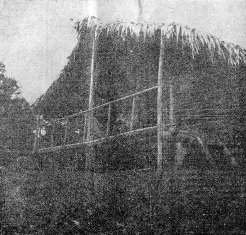 A malaria mosquito gnawed on Pvt. Jack Savage. Recuperating, Savage passes the time by letter-writing on the porch
of the log cabin where the medicos live.
A malaria mosquito gnawed on Pvt. Jack Savage. Recuperating, Savage passes the time by letter-writing on the porch
of the log cabin where the medicos live.
|
10th Air Force Scores Victory Over Monsoon
The 10th Air Force has scored a smashing victory over a new enemy, the monsoon. During the month of July, its first full month of facing some of the world's worst flying weather as well as the Japs, it delivered 70 percent more bombs on the enemy than in June and carried out missions on 27 of 31 days. Only two planes were lost, neither by enemy action.
This was revealed by Maj. Gen. Clayton L. Bissell in a press conference at 10th Air Force Headquarters, in which he summed up the activities of the force for July and also during the first full year since he assumed command on Aug. 18, 1942.
EYE-WITNESS ACCOUNT
Bissell gave an eye-witness report on the condition of the much-bombed Myitnge Bridge. "I saw it myself several days ago," he said. "The Japs are moving pontoons under the span in an attempt to raise it. They must have that bridge. Our job is to see that they don't get it." He also reiterated the announcement in a recent communiqu that the Mu River Bridge was destroyed on July 23, and told of numerous raids on Jap installations, railroads, roads and shipping.
In summing up the progress of the 10th Air Force since he assumed command, Bissell contrasted its present position with that of a year ago. "At that time," he recalled, "we had three planes, all fighters. We had bombardment squadrons without aircraft. We had virtually no fields. Even the New Delhi headquarters building was unfinished."
STRICTLY ON DEFENSE
"We were strictly on the defensive in the early days," he continued. "But you can't win wars that way. In contrast to a year ago, the 10th Air Force now is carrying the fight to the Japs throughout the entire Burma area and its sea approaches." When asked what he regarded as the principal targets in Burma, Bissell replied, "Anything that moves."
In speaking of July operations, the general related the remarkable score made by a bombardment crew in a recent raid against Burma shipping, when five ships were sunk by four bombs. The extra ship was accounted for by the fact that two ferry boats were caught tied together and sunk with one bomb.
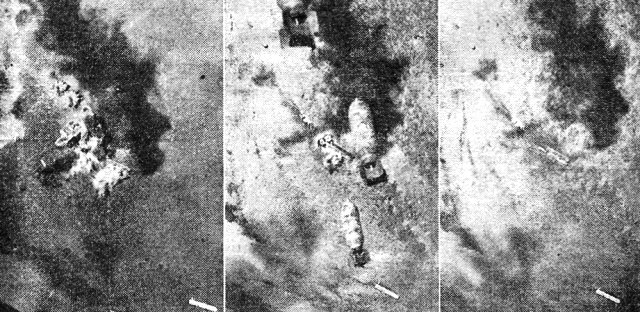 Recent communiqu s from the 10th Air Force have been telling of successful attacks upon river shipping.
Here, in three graphic pictures, is an example of the destruction being wrought against the Japs' Irrawaddy River
shipping.
Recent communiqu s from the 10th Air Force have been telling of successful attacks upon river shipping.
Here, in three graphic pictures, is an example of the destruction being wrought against the Japs' Irrawaddy River
shipping.
'Pukka Shikhari'
STERK BAGS KILLER TIGER
AIR BASE IN INDIA - Lt. Vigo H. Sterk, who used to go duck hunting on autumn weekends when he was working for the National Bushing & Parts Corporation in St. Paul, now has a new and unusual title to take back with him to America. The villagers here call him "Pukka Shikhari," which means, roughly, "Great Hunter." Sterk earned it by showing that an old Minnesota duck hunter also knows his stuff when it comes to tigers.
Sterk had heard a great deal about a local tiger which has killed innumerable cattle and goats in this locality and killed at least one Indian. He also heard that the tiger had the reputation of bearing a charmed life, because of the fact that a British sportsman had him dead in his sight recently but the tiger escaped when both barrels of a .475 caliber tiger gun proved to be loaded with dud cartridges. Sterk, however, did not believe the "charmed life" rumor.
USED SPRINGFIELD
So the other day he took a couple of hours off, rounded up a couple of hundred villagers and went out after the tiger, using a .30 caliber Springfield and expanding open-point bullets. Sterk stood near a path while the villagers beat the jungles.
Suddenly, down the path raced the tiger. Sterk shot him once at 100 yards, again at 35 yards and a third time at 20 feet, hitting him squarely each time. After the third hit, the tiger showed definite signs of discouragement. Sterk then shot him twice more and finished him.
"He came out fast," said Sterk later, "but not half as fast as a duck comes into a pond at dawn."
CARCASS DIVIDED
The local citizens divided the tiger's carcass down to the last piece of tiger liver, Sterk says. It was a big tiger, too - 10 feet, nine inches from tip to tip. The villagers, it seems, use a tiger's meat and all its innards to cure disease, to increase amatory efficiency and to bring them good luck all around. Sterk got the skin - and the name "Pukka Shikhari."
"I think I'll put it on my business cards when I get back to St. Paul - the name, I mean," Sterk said. "I'll put the skin in front of the fire-place in the living room."
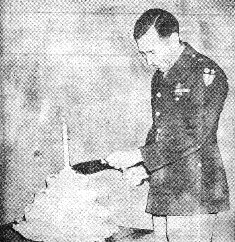 That candle on the cake Maj. Gen. Clayton L. Bissell is about to cut signifies that the general celebrated the
anniversary of his first year as 10th Air Force Commander.
That candle on the cake Maj. Gen. Clayton L. Bissell is about to cut signifies that the general celebrated the
anniversary of his first year as 10th Air Force Commander.
|
BISSELL CUTS CAKE AFTER YEAR
Maj. Gen. Clayton L. Bissell cut a cake adorned with one candle on Aug. 18, marking the completion of one year as Commanding General of the 10th Air Force.
To other claims of the 10th Air Force may be asked that of being bossed by one of the "flyingest" generals of the American Army Air Forces, or, for that matter, any commanding general of any United Nations Air Force. In performing his official duties, Bissell has flown well over 100,000 miles during the last year. His log book shows over 700 hours, which, translated into lay language, represents the equivalent of a continuous month of flight on a seven day week, 24-hour day basis. More than 100 hours of that time have been flown above enemy territory, on non-publicized bombing missions.
When Bissell took over one year ago, his command consisted of 10th Air Force Headquarters and service units, China Air Task Force, The India-China Ferry Command and certain tactical units in India which consisted of personnel without aircraft. All but three fighter aircraft ready for service were on detached service in China. All serviceable bombers and many transports which had previously operated from India had been transferred to the Middle East. Although the China Air Task Force is now the 14th Air Force, responsibility for major maintenance of all aircraft in the C.B.I. Theater remains with the 10th Air Service Command.
Bissell's year has seen tremendous advances in bombing accuracy, in combat efficiency, in new bases in China and India, in new depots, in new models of tactical aircraft, in new combat and service units. Exact details of growth cannot be stated for military reasons. he has completed ground work for greater expansion in the immediate future.
Highlights of tactical achievements of the 10th Air Force in the year under Bissell's command are:
The primary mission of protecting the air ferry has been fulfilled. The record of fighter squadrons based in India in accomplishing this mission is believed to be unsurpassed by any fighter outfit in any war theater. It has destroyed 28 confirmed Japanese fighters, bombers and reconnaissance planes, and at least 14 probables in both categories, for the loss of one pilot and plane in combat.
In support of ground forces along the Burmese border, it has contained the enemy in northern Burma.
From early March to the beginning of the monsoon, it has virtually denied the port of Rangoon to the enemy.
Its raids over Thailand represent the longest heavy bombardment missions flown in the history of military aviation. (Recent raids by U.S. Air Forces over Surabaya, Dutch East Indies and Ploesti, Rumania were shy by 200 miles-plus of this record).
The 10th also holds the distance record for medium bombers - 1,500 miles.
Enemy rail communications and vital supply and oil stores in Burma have been continuously pounded and broken.
River shipping of the enemy has been seriously hurt. Close to 50,000 tons of enemy ocean shipping has been sunk and more than 80,000 tons probably sunk.
The combined box-score of Japanese aircraft destroyed by the 10th Air Force during the period Bissell has been in command is: Confirmed destroyed: 231, Probably destroyed: 80, Damaged: 46.
Decorations awarded to 10th Air Force personnel in the past 12 months (with many more pending) have been as follows: 2 Distinguished Service Crosses, 105 Silver Star Medals, 398 Distinguished Flying Crosses, 4 Soldiers Medals, 45 Purple Hearts and 996 Air Medals.
G.I. Relates His Yarn Of Tonga Ride
CENTRAL INDIA BASE - When the American soldier first has the opportunity of strolling along the streets of an Indian city, he is vaguely conscious of something missing from an otherwise cosmopolitan scene.
Try as he might, he cannot fathom the perplexed state of his mind until he catches sight of an old Ford of 1932 vintage, wobbling and creaking around a corner with a gaily-turbaned Indian patriarch desperately clutching the wheel. Then, with a start, he realizes that though the streets are overflowing with an appalling mass of humanity they are practically devoid of the "horseless carriages" which are such an important and familiar part of American life.
The young lad from Atlanta or San Francisco doesn't have to ponder long as to how he will navigate the three crowded miles to the Municipal Zoo, for seemingly out of nowhere there is a stampede of tongas bearing down upon him with tonga wallahs screaming and shrieking in approved "Wild West" fashion and displaying wide crimson grins occasioned by the inevitable betel leaves which are chewed as tobacco. "Good horse, sahib, very good tonga, sahib," is intermingled with rapid streams of Hindustani as the ordinarily placid throngs jump and dodge to escape the slashing hoofs of 'ole dobbin.
SWIFT APPRAISAL
As is the invariable American custom, the young man makes a swift appraisal of the respective horseflesh and, finding little enough from which to choose, hops on that which is nearest and is off on as remarkable a ride as has been experienced.
The horse snorts, then again - finally balking either from hunger and weariness or in decided sympathy with the cause of the Indian Congress nationalists. Whatever it may be, the brutal lashing of the whip conveys the logic of the adage that discretion is the better part of valor and the emaciated beast moves forward. The tonga creaks as the "ghora" quickens its step, the tonga wallah grunts with satisfaction and the passenger grabs what he considers to be the most permanent fixture on the remarkable vehicle in a desperate effort to prevent being bounced out.
After several miles at a sedate pace, which, of course, is quite customary in this land of mystery and intrigue, the swash-buckling Yankee demands the speed to which he is accustomed. he motions to the driver to get this damn buggy rollin'. After several futile attempts with sign language, the happy thought occurs that this is the appropriate time to practice a bit of the Hindustani which he has been so laboriously learning.
SWIFT CONVERSATION
"Jaldi jao," he shouts to the unperturbed tonga wallah and, after he has exhausted all intonations and accents within his limited range, he mildly says, "C'mon Joe, let's snap it up. I ain't got all day." The tonga wallah looks around with a toothless grin and mildly agrees: "O.K., George," whereupon the tonga pony is again soundly thrashed as it makes that final effort so worthy of thoroughbreds, but, alas, crumples in an exhausted heap in the middle of the next busy intersection.
The young American speed-demon and defender of this inimitable conglomeration of peoples - with all the ruefulness of finding himself sprawled upon the hard surfaced road - sits up moaning softly and with a grim determination to do as the Indians do when in India.
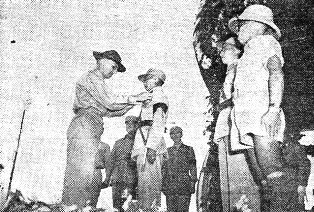 Lt. Gen. Joseph W. Stilwell pins the Silver Star on the breast of Capt. Ho Peng-chi for heroism in the Burma campaign
of 1942. Two other members of a Chinese-American training center in India, Capt. Lee Chi-yuan, left, and Sgt. Ching Wun-fei,
also received Silver Stars for gallantry in the same campaign.
Lt. Gen. Joseph W. Stilwell pins the Silver Star on the breast of Capt. Ho Peng-chi for heroism in the Burma campaign
of 1942. Two other members of a Chinese-American training center in India, Capt. Lee Chi-yuan, left, and Sgt. Ching Wun-fei,
also received Silver Stars for gallantry in the same campaign.
|
Presented Silver Stars
CHINESE-AMERICAN TRAINING BASE - Before 20,000 battle-equipped Chinese soldiers at this India-based center, Lt. Gen. Joseph W. Stilwell, C.B.I. Commander, awarded the Silver Star to two captains and a sergeant of the Chinese Army for their outstanding acts of gallantry during the campaign of 1942 against the Japanese.
Prior to the reading of the citation and presentation of the award, Stilwell, in a brief address to the assembled command, said, "Although you have made excellent progress in your military training, you must remember at all times our objective - to open up China's life line. The Chinese people are depending upon us to do it, and we must not fail them. China now has powerful Allies among the United Nations. We cannot lag behind.
HAVE MANPOWER
"We have all the men necessary for victory. I have always had great confidence in you. Our success in battle depends upon the best efforts of every man in our team. From the Army commander on down, I am depending upon every one of you to do his full duty to defeat the enemy, to recover lost territories, to save China."
Col. John Liu, Stilwell's liaison officer, then read the citations, awarding the Silver Stars to Capt. Ho Peng-chi, of Szecsuan; Capt. Lee Chi-yuan, of Chekiang, and Sgt. Ching Wun-fei, of Szecsuan.
Ho Peng-chi led his company in a determined and successful assault against an entrenched enemy position on March 28, 1942. Again, April 13, he commanded his company skillfully during a rear guard action against a greatly superior force, permitting the safe and orderly retreat of the main body.
'ACT OF GALLANTRY'
Lee Chi-yuan led a platoon which on April 13, 1942, successfully resisted three enemy attacks and inflicted heavy casualties, although greatly outnumbered. Lee's courage and determined resistance in defending his position in spite of mounting casualties was lauded in the citation as "a marked act of gallantry."
During the Burma campaign, Ching Wun-fei was ordered to lead half of his unit on a flanking scout movement. While thus engaged, he observed the approach of enemy patrols greatly superior in number. Carefully concealing his men, Ching ordered his men to hold their fire until the enemy was within close range and then attacked and routed them.
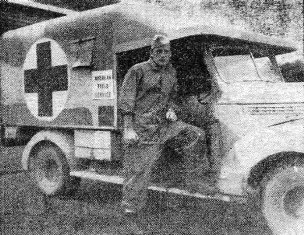 Two former athletes were turned down by the armed forces, so they volunteered for the American Field Ambulance Corps
and are serving in India. Former Middlebury College football coach, Richard Field, above, has only half vision
in one eye, while Edward Brennan, ski star, was turned down 15 times by the Army, Navy and Air Forces after breaking a
leg. He wouldn't take "no" for an answer.
Two former athletes were turned down by the armed forces, so they volunteered for the American Field Ambulance Corps
and are serving in India. Former Middlebury College football coach, Richard Field, above, has only half vision
in one eye, while Edward Brennan, ski star, was turned down 15 times by the Army, Navy and Air Forces after breaking a
leg. He wouldn't take "no" for an answer.
|
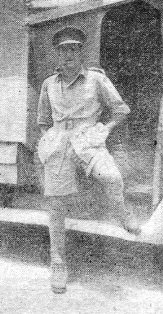
|
FESSEL'S WOODEN CHISELS
DARNED THINGS WOODEN CHISEL
Lt. Arne E. Fessel, Contracting and Purchasing Officer at SOS, was sitting at his desk fingering a thin, elongated object the other day when a friend walked in the office.
"Know what this is?" Fessel asked.
The other inspected it and had to admit that he had no idea.
"Well," returned Fessel, "here's the story. A few days ago I ordered some wood chisels from a firm in town. Now you know the way things get mixed up over here. I spoke very carefully to the man to be sure I would get what I wanted - wood chisels. He listened, said he could make them, and today this object came to my desk - and, dammit, look at it: A perfectly carved wooden chisel."
The look of near suicide, on Fessel's face frightened the friend and he left him to his grief, muttering incoherent words about the wooden chisels that wooden chisel.
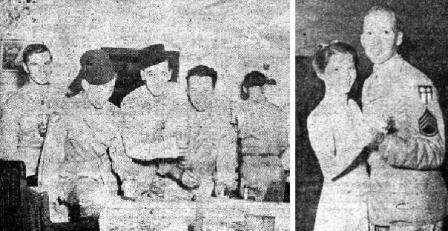 Joy was unconfined at the IATF Headquarters NCO Club t'other evening, as these pictures help confirm. Left, meet
the "Four Silly Sheiks," starring, left to right, Sgt. Dick Moore, Sgt. Clyde Woody, Sgt. Elmer Lamond and Pfc. Dave
Schooler. The bandaged arm was incurred prior to the present affray. At right, lens-happy S/Sgt. Karl Peterson, one of the
Roundup's leading corn merchants, and Patricia McDonnell smirk into the hard-working shutter-snapper's camera.
Joy was unconfined at the IATF Headquarters NCO Club t'other evening, as these pictures help confirm. Left, meet
the "Four Silly Sheiks," starring, left to right, Sgt. Dick Moore, Sgt. Clyde Woody, Sgt. Elmer Lamond and Pfc. Dave
Schooler. The bandaged arm was incurred prior to the present affray. At right, lens-happy S/Sgt. Karl Peterson, one of the
Roundup's leading corn merchants, and Patricia McDonnell smirk into the hard-working shutter-snapper's camera.
|
Club Sets 'Em Up
At India Base
IATF HEADQUARTERS - If "man bites dog" is news, how's this: American soldier in India receives - repeat - receives "baksheesh," the occasion being the IATF NCO Club party last week when the drinks 'n' everything were "on the house." As M/Sgt. Marvin Swallow, club president, explained, "We haven't been collecting dues for three months, but with the bar operating every night the Treasury got pretty fat, so we just declared a dividend."
Music for dancing was furnished by the popular BESA orchestra, M/Sgt. "Steve" Stevens set out a buffet supper fit for a Pharaoh, and those two (non-singing, thank Heaven) bartenders, T/Sgt. Ed Succop and Pvt. Harold Brockman, whipped up a batch of punch. The punch was the focal center of the whole brawl.
The witches' brew, from a recipe of Maj. G. R. Norman, is designed to grow pink moss on the imbiber's chest and leave him barking like a jackal. It consists of rum, brandy, Vermouth, and (can you take it?) tea, in roughly equal parts. Where such a normally peaceful and genial citizen as the major got the prescription is unknown, probably from a bottle found floating in the Sargosso Sea. The guy who stated that one swallow doesn't make a summer never took a swig of Norman's Nasty Nostrum.
Thus lubricated, the party, superfluous to say, was some soiree, and pronounced a big success (by those who could still pronounce) when the last jitterbug had been shooed home and the groaning sideboard unburdened.
Two unsung heroes of the affair were Pvt. Grady Ammons and Pfc. Joe Rose, who volunteered to stay afterwards and clean up the club room. Principal item cleaned up was the remaining punch, and the cold light of morning revealed a certain soldier enjoying a "spot of shooting" in the field outside the barracks, trying his Springfield on some quizzical blackbirds. S/Sgt. Roscoe Alexander was first sleeper to "hit the deck," and his irate descent on the happy huntsman restored the early morning quiet.
 Intensive preparation for jungle warfare is part of the training program given to American-trained Chinese troops in
India, with particular emphasis upon employing jungle resources against the enemy. Left, punjies - split and sharpened
bamboo - are being made for a camouflaged pit such as appears in the center panel. Right, a concealed Chinese soldier
is poised for action with a Bren gun, using a vine tied to a tree to steady his weapon.
Intensive preparation for jungle warfare is part of the training program given to American-trained Chinese troops in
India, with particular emphasis upon employing jungle resources against the enemy. Left, punjies - split and sharpened
bamboo - are being made for a camouflaged pit such as appears in the center panel. Right, a concealed Chinese soldier
is poised for action with a Bren gun, using a vine tied to a tree to steady his weapon.
|

THE ROUNDUP IS OUT TODAY The dogs are reading books, The apes are playing dice. The rats are running in the holes And dancing with the mice. The cows are dancing 'round, The chickens are playing ball; All the goldbricks' work now, They no longer stall. The goats are eating cans, The flies are drinking spry, For everybody's happy - The ROUNDUP'S out today. - By Cpl. LEONARD F. SMITH |
|
FOR DISCHARGED G.I.'S WASHINGTON - UP - Acting Secretary of War Robert Paterson announced that service lapel buttons will be awarded to men and women who have been honorably discharged from the Army during this war. The buttons will be small, gold-plated and made of plastic, containing an eagle within a circle with his wings extending beyond the circle's edge. 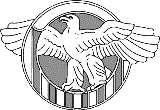
|
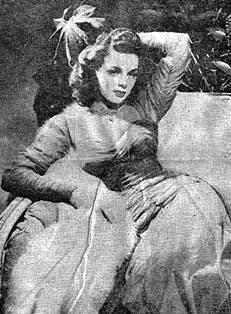 Who dares refute the Roundup's claim that Margaret Chapman is easy on the eyes?
All objectors should pay an immediate visit to the Medical Corps.
This, say we, is worth three columns any day.
Who dares refute the Roundup's claim that Margaret Chapman is easy on the eyes?
All objectors should pay an immediate visit to the Medical Corps.
This, say we, is worth three columns any day.
|
The C.B.I. Roundup is a weekly newspaper published by and for the men of the United States Forces in China, Burma, and India, from news and pictures supplied by staff members, soldier correspondents, Office of War Information and other sources. The Roundup is published Thursday of each week and is printed by The Statesman in New Delhi, India. Editorial matter should be sent directly to Major Fred Eldridge, Rear Echelon, Hq., U.S.A.F., C.B.I., New Delhi, and should arrive not later than Monday in order to be included in that week's issue. Pictures must arrive by Sunday and must be negatives or enlargements. Stories should contain full name and organization of sender.

AUGUST 19, 1943
Original issue of C.B.I. Roundup shared by Ruth Canney, widow of CBI veteran John Canney.
Image of service lapel button (the Ruptured Duck) did not appear in the original paper.
Copyright © 2006 Carl Warren Weidenburner
TOP OF PAGE PRINT THIS PAGE ABOUT THIS PAGE SEND COMMENTS
PREVIOUS ISSUE CLOSE THIS WINDOW NEXT ISSUE